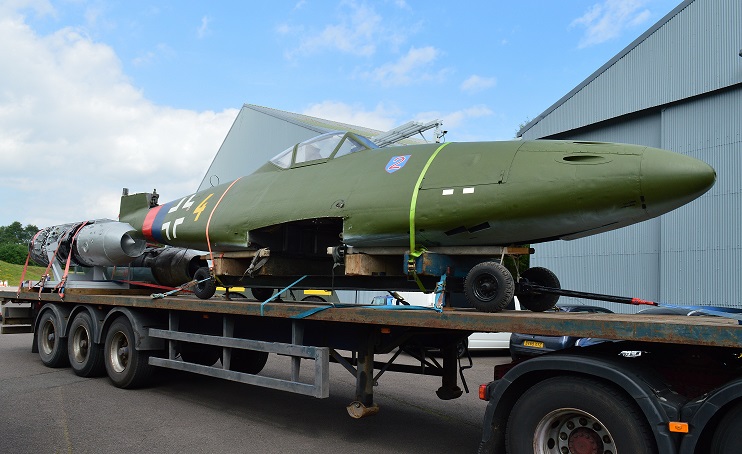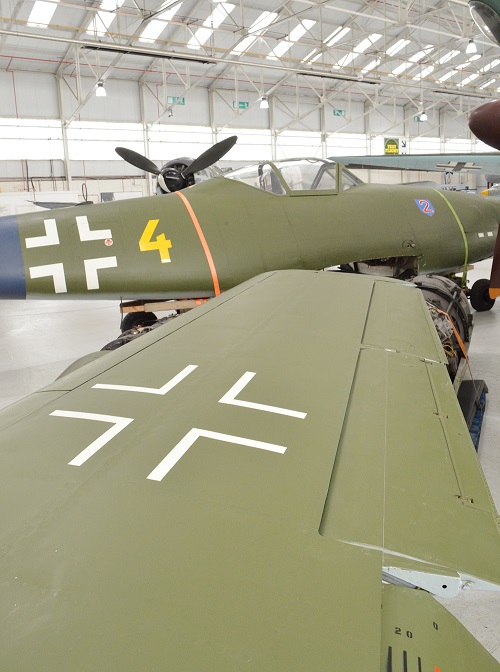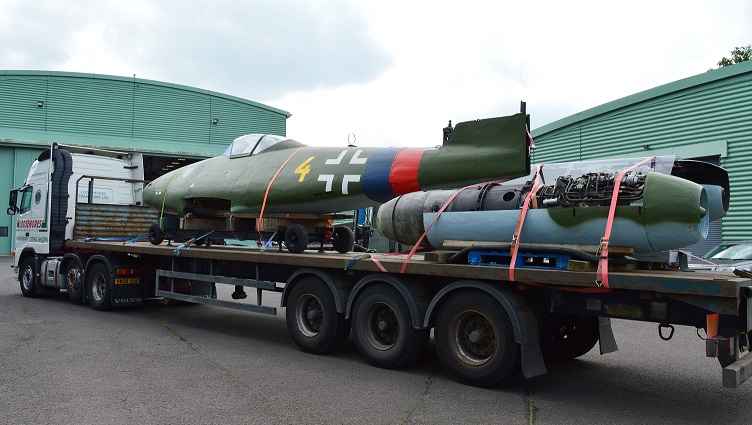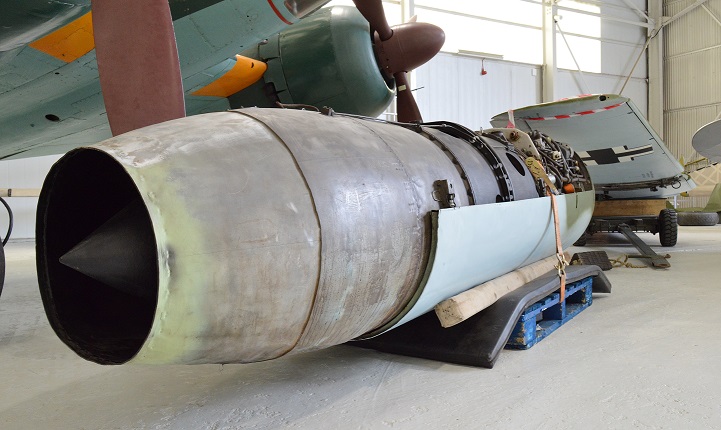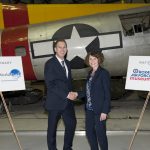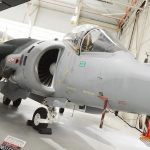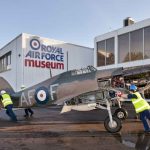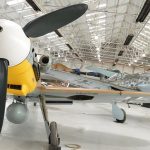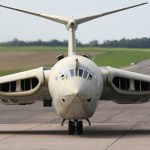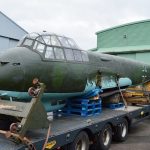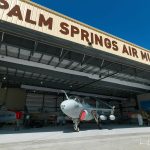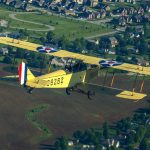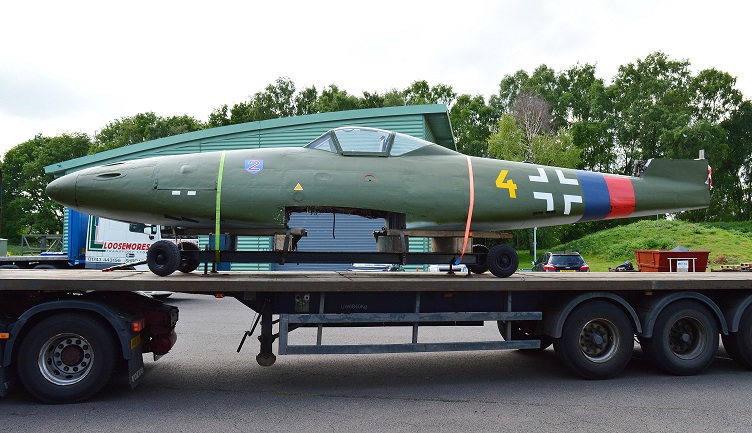
The most advanced fighter aircraft of the Second World War, the Messerschmitt Me 262, has been transported by road to its new home at the Royal Air Force Museum Cosford. This particular aircraft, Messerschmitt Me 262A-2a Schwalbe (Swallow) can already be seen by members of the public in its dismantled condition within one of the Museum’s display hangars. The Me 262 is returning to Cosford after 14 years on display at the RAF Museum London. Prior to the move the aircraft was dismantled by Museum Technicians and Apprentices and arrived safely at Cosford just under a week ago. Over the coming weeks it will be re-assembled and displayed alongside fellow German fighters the Me109, FW190 and the Ju88 night fighter in the ‘War in the Air’ hangar. This fleet of rare Second World War Luftwaffe aircraft is a huge pull for Cosford, which is also home to their rival RAF equivalents.The Me 262 was the only jet fighter to see air-to-air combat in the Second World War and its appearance was a great shock to the Allies. It was a significantly more advanced design than its British counterparts and many of its aerodynamic secrets were eagerly incorporated in later post-war combat aircraft.
Preliminary design work on what was to become the Me 262 began in 1938. Persistent problems with the turbojets intended for the aircraft delayed the project and the first flight by a Me 262 using jet power alone did not take place until July 1942. In December 1943 Hitler decreed that the Me 262 Schwalbe (Swallow) should only be manufactured as a fighter bomber. Senior Luftwaffe officers believed that the Me262 was more valuable as a fighter, and Hitler’s wishes were initially ignored much to his subsequent fury.Small numbers of Me 262 fighters and fighter bombers were used operationally by the Luftwaffe from mid-1944. Allied pilots found the Me 262 a formidable opponent and special tactics were adopted to meet the new threat. However, chronic supply shortages meant that few Me 262s saw combat and the true potential of the Me 262 was never realized.
Ian Thirsk, Head of Collections at the RAF Museum said:“The first Messerschmitt Me 262’s entered service in the autumn of 1944, as the first turbojet fighter to do so it heralded a new era in aerial warfare and represented a step change in technology. Today very few original examples survive so we are delighted to present this significant aircraft to our visitors at Cosford. Following the RAF Cosford Air Show on 11 June, the Me 262 will be reassembled so now is a good opportunity to catch a rare glimpse of this famous aircraft in its dismantled state.”
The new arrival isn’t alone….a second aircraft to move up to Cosford from London in recent weeks is the Hawker Hart Trainer, an advanced trainer version of the original Hawker Hart bomber. The Hart was introduced in 1930 and immediately became a great success; its performance exceeding that of contemporary fighters. The basic design was readily adapted for other roles including a fighter variant (the Demon) and an Army Co-operation version (the Audax). Aviation fans can now view the Hart in Hangar 1. Both new arrivals are in addition to the six aircraft transported to Cosford at the end of 2016/early 2017 which include the Messerschmitt BF109G-2, the de Havilland Tiger Moth II, the Junkers Ju88 and the Gloster Gladiator 1, all four aircraft are now on display. The Wolverhampton built Boulton Paul Defiant Mk.1 will be joining the new line-up in the ‘War in the Air’ hangar soon and will be positioned alongside the Gladiator, whilst the Westland Lysander III will remain in the Conservation Center and will undergo some minor repair work to its fragile linen skin.
The aircraft moves come as the Museum prepares for the Royal Air Force’s centenary celebrations in 2018 that will see the Museum transform its London site with a series of new permanent exhibitions opening in the summer of 2018. The multi-million pound development programme will see investments in new exhibitions, improved education and volunteering opportunities, and landscaping that will emphasise the site’s importance as a heritage airfield. It will improve the visitor experience, extend the Museum’s reach to new audiences and create a lasting legacy to mark the Centenary.
The enhanced aircraft collection at Cosford will enable the RAF’s story to be more comprehensively represented to Museum audiences in the Midlands. In addition, plans for 2018 will include displays exploring the first 100 years of the RAF, the role it plays today and its future contributions. Making the RAF story available to a global audience there will be a huge investment in the Museum’s online offer.
Aviation fans can keep up to date with the centenary aircraft moves and on-going developments by signing up to the Museum’s free e-Newsletter http://www.rafmuseum.org.uk/contact-us/newsletters.aspx . The Museum is open daily from 10am until 5pm and entry is FREE. For further information, please visit the Museum’s website www.rafmuseum.org/cosford.








